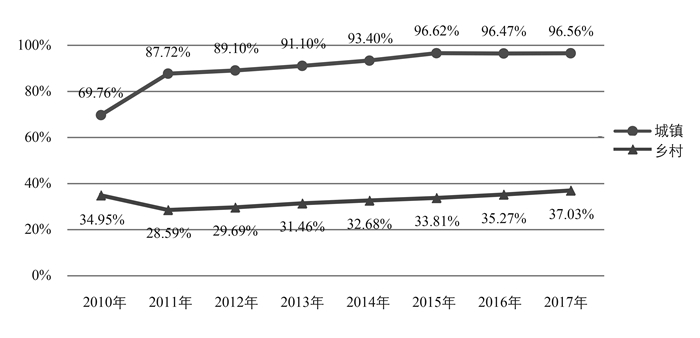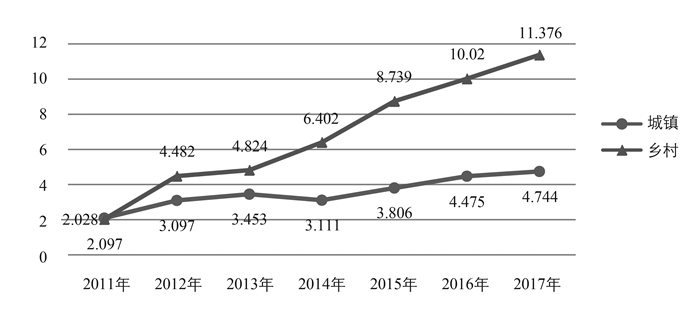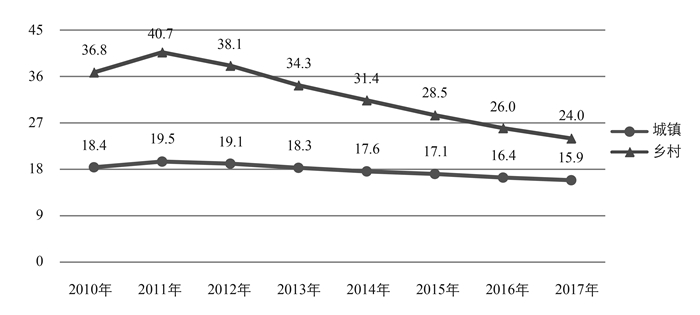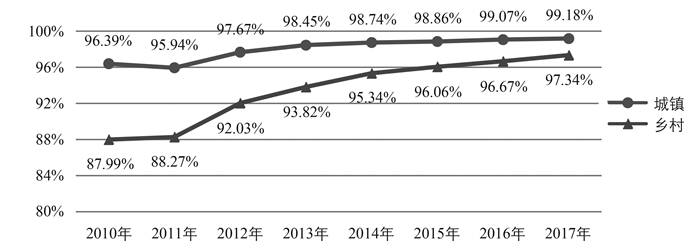全文HTML
-
联合国教科文组织在《学会生存》中明确指出:学前教育是一切教育和社会文化政策的前提条件。学前教育是基础教育的根基,也是终身教育的开端。1837年德国福禄贝尔幼儿园的创立,意味着真正意义上的学前教育机构兴起,于19世纪中期开始风靡各地。20世纪初,幼儿园传入中国,1903年我国第一所官办学前教育机构——湖北幼稚园建立。随后,我国正式的学前教育逐渐兴起。
在新的历史时期,政府相继出台了多项政策方针为我国学前教育的发展保驾护航。2001年教育部颁布《幼儿园教育指导纲要(试行)》,明确提出学前教育是基础教育的重要组成部分,是学校教育和终身教育的奠基阶段[1]。“十二五”期间,在《国务院关于当前发展学前教育的若干意见》的基本精神指导下,我国学前教育事业迅速发展,在扩大教育资源、普及学前教育、提高学前教育质量等多方面取得了显著成就。但受历史和社会发展的制约,城乡学前教育发展的差异化现象突出,优质学前教育资源分配不合理[2]。
学前教育公平是教育和社会公平的起始点,在宏观上指适龄儿童享有平等的受教育权利和机会,同等共享公共教育资源,保障社会弱势群体利益[3]。这已成为国际社会的共识[4]。如何实现《国家中长期教育改革和发展规划纲要(2010-2020年)》中“重点发展农村学前教育”[5]这一目标?如何实现学前教育资源均衡配置的目标?如何缩小城乡间学前教育发展的差距?首先要对城乡间学前教育发展差异有精准的认识。为此,本文基于CIPP测评理论,尝试建构我国城乡学前教育均衡发展的测评指标体系,对我国2010-2014年的城乡学前教育发展均衡程度进行测算,综合计算教育基尼系数,评估我国学前教育发展的城乡均衡水平及其具体差异化情况,建立利用综合教育基尼系数测评城乡学前教育发展均衡程度的方法体系。
-
经合组织(OECD)将“结构质量”(structural quality)和“过程质量”(process quality)作为学前教育质量的二元要素。其中“结构质量”由硬件设施、资源、师资力量、师生比等要素外显化。“过程质量”的评价要素包括:师幼互动、教师教学技巧、幼儿园的领导和管理等[6]。国内最具代表性的是袁振国提出的“生均经费”“师资力量”“物质资源”和“学生辍学率”四位一体的教育发展均衡指标[7]。
-
1.CIPP测评指标框架
CIPP模式是由美国著名教育测评专家斯塔费尔比姆(L.D.Stufflebeam)于20世纪60年代提出的一种以决策为中心的测评模式。他提出,在教育过程中,存在着四种类型的决策,即计划决策、组织决策、实施决策和再循环决策,相对应的四种测评过程为:背景测评(context evaluation)、输入测评(input evaluation)、过程测评(process evaluation)及结果测评(product evaluation)。
在学前教育阶段实施“均衡发展”的方针,体现了学前教育以公平为主的价值属性。学前教育公平的内涵主要表现在起点公平、过程公平和结果公平。起点公平是教育公平的前提,过程公平是教育公平的条件和保证,结果公平是教育公平的结果[3, 8]。其中起点公平,即权利和机会均等,对应CIPP测评模式中的背景测评,即在实现学前教育前所必需的入园机会的测评,对应一级指标“教育机会”。过程公平,即公共教育资源的分享公平和教育质量公平,对应CIPP测评中的输入和过程测评,即在起点公平测评的基础上,对达到目标所需进行投入的测评和方案实施过程中的保教质量的过程性测评,分别对应一级指标“教育投入”和“保教质量”。结果公平,对应CIPP测评中的结果测评,即方案达到,影响目标受众程度的测评,对应一级指标“教育结果”。上述三个内涵(起点公平、过程公平、结果公平)、四个一级指标(教育机会、教育投入、保教质量、教育结果)与CIPP模式的四点构成要素(背景测评、投入测评、过程测评和结果测评)基本吻合。
2.基本原则
OECD各国学前教育质量监测方式不尽相同,但实施质量监测的目标基本一致,即问责、干预、支持政府决策、为公众提供信息改善学前教育质量。在督导评估中,以外部监测方式为主,以保障评估的客观性和权威性。与此同时,虽然OECD各国均开始关注过程性质量,例如师生互动的质量等[9],但是数据的可得性以及指标对学前教育质量的可预测性是确定质量监测内容的重要衡量要素[10]。而且,结构性质量便于从投入视角来衡量,更易被量化,所以督导评估的内容多针对结构变量[9],例如师幼比。有研究指明,师幼比是衡量学习环境质量高低的主要指标,良好的师幼比有利于提高师幼互动的有效性[11],是保教质量最为典型的评估指标。所以本次建构学前教育城乡均衡发展的评价体系时,坚持以外部监测为主,考虑评估指标的易量化原则以及数据的可得性和可预测性,在二级评估指标的筛选上,以结构性变量为主。
-
1.教育机会公平
受教育机会公平是教育起点公平的首要指标,是评估投入公平、过程公平和结果公平的基本背景,起点公平是保障过程公平和结果公平的前提条件。教育机会指适龄儿童是否获得入学机会,表现为入学规则不因个人意愿以外的其他原因而改变。入园率是测算教育机会最为直接的指标,统一标准,采用学前三年毛入园率作为分析城乡教育机会差异的可操作性指标。
2.教育投入公平
如今,世界银行(WordBank),联合国教科文组织(UNSCO),经济合作与发展组织(OECD)等国际组织在敦促世界各国承担发展学前教育的责任,提高对学前教育的投入力度,保障高质量的学前教育服务体系。随着公共投入的迅速增长,对公共投入公平的关注也在逐渐升温。促进学前教育的普及程度,提高学前教育的质量,扩大学前教育资源,需要有大量的财政投入作为支撑。所以将生均公共财政支出作为衡量城乡教育投入差异的重要指标,与此同时主要考虑分配至公办园幼儿的经费份额。
3.保教质量公平
保教质量在一定程度上反映公共教育资源的配置结果,公共教育资源公平是实现教育过程公平、受教育者享有同等教育资源服务的基本保障[3]。教育资源包括人力和物力资源,人力资源主要指教师数量、学历等师资力量,物力主要指校舍、图书等办学条件。人力和物力资源是财力资源(教育经费)支出的结果,也是保教质量的充分条件。对于城乡间保教质量的差异,从师资水平和办学条件两个方面进行分析。
学前教育师资队伍的建设,是实现提高学前教育质量的基本保障条件。其中师资水平从量到质进行考核。数量上,比较生师比、公(民)办园的园均教师数;质量上,比较幼儿教师的学历层次、幼儿园园长的学历层次。生师比反映了多少个学生被一个教师服务,是度量教师服务所教学生精力是否足够的重要指标。公(民)办园均教师数反映办园体制下师资配比的基本现状。专任教师学历结构体现教师的专业水平。园长学历结构体现园区管理的专业水平。教师的数量和质量不仅反映人力资源配置的基本情况,而且与教育质量直接相关。
办学条件的好坏,是衡量保障幼儿良好学习生活环境的重要指标,是指学校在占地、基础建筑设施、教学设施设备、教辅设施设备、师资配备等几方面的综合配置状况[3]。主要参考《中国教育统计年鉴》上公布有数据的指标园舍面积、活动室面积、户外活动室面积和图书册数。其中,“园舍面积”在一定程度上反映学前教育的办校规模,也间接反映出该校可容纳的学生、教职工数量,是学前教育学校建设的重要参考指标之一。
4.教育结果公平
人们对于教育结果、教育质量的价值观不同,如何量化教育质量更是莫衷一是的议题。基于筛选指标易量化,数据易得性,以及选取结构性指标的原则,选择小学新生中受学前教育比例作为度量教育结果公平的指标。
一. 建构依据
二. 指标要素
-
基尼系数是意大利经济学家基尼(G.Gini)依据洛伦茨曲线性质提出的判断收入分配差异程度的定量指标。它不仅可用于研究一切分配问题(包括收入分配),亦适用于对均衡程度的分析,教育基尼系数已经逐渐成为国际上测度教育均衡程度的通用指标[12]。例如,国际上Mass&Criel通过初等教育的入学率,估算了东非16个国家的教育基尼系数[13]。我国从20世纪90年代开始出现借助教育基尼系数研究教育均衡情况的相关研究。故本文借助基尼系数方法,计算出各级教育指标的基尼系数,因各项指标在总体评估框架中重要性程度不一,即权重不一,在此基础上,运用基尼系数客观赋权法,综合测算教育发展均衡情况。
-
计算基尼系数最为基础的方法之一是借助洛伦兹曲线计算面积,但比较繁琐,本文借鉴习明等开发的简便计算方法——未分组离散数据基尼系数协方差公式来计算基尼系数[14]。
设n个对象的K指标分别为xk1,xk2,……xkn,且xk1<xk2<……<xkn,uk是k指标平均值,则
根据国际组织的通行规定,通常将0.4作为收入分配差距的“警戒线”,基尼系数取值为0~0.2为绝对平均,0.2~0.3为比较平均,0.3~0.4为相对合理,0.4~0.5为差距较大,0.5以上为差距悬殊。而由文献分析,在教育评估领域,并没有如上述确切的阈值划分[12],且在计算城乡二元混合基尼系数的理论中,有采用城乡组间差异和城乡组内差异之和的方式,如Sundrum, R.MG=
$p_1^2\frac{{{u_1}}}{u}{G_1} + $ $p_2^2\frac{{{u_2}}}{u}{G_2} + {p_1}{p_2}\left| {\frac{{{u_2} - {u_1}}}{u}} \right|$ [15]。为了便于统计,在城乡二元视角下,我们采用衡量组间差异度为主的计算理论,所测得的基尼系数值忽略城镇内部以及农村内部所产生的差异值。所以本研究的基尼系数不划分确定差异程度的范围,仅利用其绝对值的价值属性比较指标间和指标内的差异度。 -
如何确定测评指标的权重是指标决策的首要问题。赋权法包括主观赋权法和客观赋权法两类,其中主观赋权法主要有层次分析法(AHP)[16],序关系分析法(G1-法)[17]和唯一参照物比较判断法(G2-法)[17],其优点是权重能够反映专家意见,但弊端在于权重受人为因素影响较大且忽略指标的原始数据信息;为了更好地反映指标的数据信息,例如复相关系数法[17]、熵权法[18]、灰色关联分析法[19]、Critic法[20]和DIDF法[21]等具有代表性的客观赋权法应运而生。
本文采用李刚等提出的基尼系数赋权法[22],其研究发现基尼系数赋权法具有实用性和保序性的优势。基尼系数赋权法是将测评指标的基尼系数进行归一化得到测评指标权重(见公式二),即通过基尼系数值的大小反映该指标不同测评对象之间的数据差异的大小,同时保证所有指标的权重都在0到1的范围内且和为1。
-
${G_i} = \sum\limits_{k = 1}^n {{r_k}} {g_k}$ (公式三),其中gk为第i指标下第k项二级指标的基尼系数,rk为其在第i指标下的权重。
一. 计算各二级指标的基尼系数
二. 计算各二级指标的权重
三. 计算一级指标基尼系数
-
通过《中国教育统计年鉴》(2010-2017)、《中国教育经费统计年鉴》(2011-2018)、《中国人口统计年鉴》(2010-2017)收集计算各二级指标的基本数据,运用基尼系数算法(公式一)计算各指标的城乡差异指数(见表 2),再运用基尼系数客观赋权法(公式二、公式三)计算整体差异指数(见表 1)。
① 本研究中,学前三年毛入园率=(在园幼儿总数/3~6岁幼儿人口总数),其中,在园幼儿数来源于2010-2017年《中国教育统计年鉴》,幼儿分年龄段人口数据来源于2010-2017年《中国人口和就业统计年鉴》;生均公共经费指公共财政支出(包括教育事业费、基建经费和教育费附加)/在园人数与公办园学生数占比之积;专任教师(园长)学历比指专科及以上学历教师(园长)占比;公(民)办园均教师数指公(民)办教师数与公(民)办园数;生均活动面积指生均户外活动面积与生均室内活动面积之和;受学前教育比例指小学新生中受过学前教育新生占比。
由表 1可知,各指标(除教育投入指标外)城乡差异均呈现减少趋势,但是差距依然存在。作为起点公平的教育机会差异系数最大,除2010年外,均保持在0.223~0.254之间(>0.2);其次是保教质量指标,其中师资力量差距更为显著,八年里差异系数保持在0.206~0.223之间(>0.2);再者是教育投入,差异在波动中呈现增长趋势;最后是教育结果指标中小学新生中受学前教育比例在逐年递减。
-
毛入园率的高低是反映适龄幼儿接受学前教育机会的重要指标。由2010-2017年基尼系数发展趋势看(见表 2),我国城乡学前三年毛入园率存在较大差距,呈现先增长后缓慢下降趋势,至2017年,差异指数(基尼系数)仍有0.223(>0.2)。其中城镇适龄儿童学前三年入园率波动中有增加,乡村适龄儿童学前三年入园率呈现先降后升趋势,截至2017年,城镇学前三年毛入园率已达96.56%,农村为37.03%,相差约60个百分点。
-
公共教育经费是学前教育经费中最关键、最重要的指标。从2010-2017年基尼系数发展趋势看(见表 2),城乡生均教育经费投入差距呈现先增后减再增的趋势,差距较为明显,至2017年差异指数上升至0.206。自2012年起,农村幼儿生均教育经费高于城镇生均教育经费。从学前教育投入总经费上分析,城乡的总经费投入逐年增加,差距逐年减少,2011年农村教育经费投入总量是城镇经费投入总量的0.55倍,2017年上升至1.08倍。而公办园是政府直接提供学前教育公共服务的典型方式,也直观具体地反映了政府对学前教育的直接投入和供给[23]。城镇公办园在园人数逐年增加,农村公办园在园人数逐年减少,差距逐年增加,2017年农村公办园在园人数是城镇公办园在园人数的0.45倍。农村公办园在园学生减少,公办园公共经费投入增加,而不把民办园纳入考虑,容易出现农村生均教育经费投入高于城镇经费投入的假象。
-
1.城乡生师比虽逐年减少,但乡村师资配备数量显著不足
生师比是衡量学前教育保教质量的一个重要指标。从2010-2014年基尼系数发展趋势看(见表 2),我国城乡学前教育生师比差距呈现先增大后减少趋势,至2017年下降至0.102。城乡学前教育生师比均呈现先增后减趋势,且乡村生师比远远超过全国平均水平,至2017年约为24.0:1,是城镇生师比(15.9:1)的1.5倍,师资的配备数量显现出显著的城乡差异。
2.城乡师资学历结构虽逐年优化,农村学前教育师资力量仍较薄弱
从师资的学历结构基尼系数来看(见表 2),城乡幼儿园专任教师、园长(专科及以上)学历占比差距仍然存在,分别在0.04~0.11和0.02~0.09范围内缓慢减少。从师资的学历结构发展趋势看,城乡专任教师和园长(专科以上)学历占比均逐年增加,至2017年,城乡“专科及以上”专任教师占比相差约14个百分点,“专科及以上”园长数相差约8个百分点。同时,城镇专任教师“研究生”和“本科”学历占比仅分别为0.31%和24.1%,农村分别为0.06%,14.46%;城镇园长“研究生”和“本科”学历占比分别为1.33%和37.04%,农村分别为0.2%和23.53%。学前教育城乡间的师资结构配比差异化现象突出,农村学前教育师资力量亟须进一步加强。
3.公(民)办园园均教师数:乡村园园均教师数明显少于城镇,且公办教师少于民办
从公、民办园视角分析师资数量配比可以发现,城乡公(民)办园园均教师差异系数均整体呈现先增后减趋势(其中公办园城乡差异系数有小幅增长态势,见表 2),且城乡公办园园均教师差异系数差距显著(差异系数均超过0.3)。从纵向看,城镇公(民)办园园均教师数均明显多于农村公办园园均教师数;从横向看,城镇公办园园均教师数均显著多于民办园园均教师数,农村公办园园均教师数均显著少于农村民办园园均教师数。可见农村师资力量配比薄弱,且主要表现在公办园师资力量配比上。
-
从幼儿园教育质量的结构性指标如生均园舍面积、生均图书册数、生均室外(内)活动面积的近五年基尼系数来看,尽管有逐渐减小趋势,但差距仍然十分明显。而城乡生均园舍面积和室内(外)活动面积呈现先减后增趋势,生均图书册数呈现逐渐递增趋势,我国乡村地区办园条件和幼儿学习生活条件与城镇幼儿相比依然比较落后。
-
有研究表明,是否接受过学前教育对儿童入小学后的成绩是有影响的,这种学前教育的开端效应存在且对学生的影响久远[24]。由近五年小学新生中受学前教育幼儿比例的基尼系数来看,城乡差距不断缩小,但差距依然存在。且城乡受过学前教育的小学新生比例均呈增加趋势,至2017年,城镇99.18%的小学新生都接受过学前教育(包括学前班),农村则达到97.34%。
一. 背景不公平:城乡幼儿入园机会严重失衡
二. 输入不公平:农村扶持力度加强,乡村生均公共经费高于城镇,但惠及面小
三. 过程不公平:师资力量差距悬殊
四. 过程不公平:城乡保教质量之办园条件差距明显
五. 结果不公平:城乡小学新生受学前教育比例差距缩小,但依然存在
-
城乡学前教育背景(即起点)发展不公平是由社会经济和社会文化共同作用的结果。首先,城乡二元经济发展结构是导致学前教育机会不公平的根本原因,长期以中央、城市为主,忽视地方、乡村的二元经济划分发展方式,导致城乡经济水平差距愈加显著[25]。长期滞后的农村经济直接影响着农村学前教育的发展水平以及普及程度,使农村学龄儿童的入学机会、学前教育的教育质量等远远落后于城市的对应指标水平。其次,城乡家庭经济水平不均衡也是影响幼儿受教育机会不公平的重要因素。一些经济水平不佳的农村家庭,由于无法为非义务教育的幼儿园收费买单,导致大量的农村适龄幼儿无法拥有接受学前教育的机会。而城乡社会文化结构不均衡是导致教育机会不公平的最为潜在原因。随着社会文明程度的不断提高,“读书是唯一的出路”已成为寒门学子信奉的真理。对于文化程度普遍不高的农村家庭来说,对幼儿教育价值认识不足,忽视幼儿教育。任何实践行动总是源于观念的支撑,如果说没有足够的经济收入是导致农村毛入园率低的直接原因,那么观念上没有意识到学前教育的重要性是导致教育起点不公平的必然因素。
-
随着国家近几年对农村学前教育的扶持力度加强,农村经费看似不断增长,但结合农村极低的入园率(近几年最高仅为32.68%)以及公共经费投入公办园为主的两点思考,学前教育经费对农村的投入实则远远不够,城乡差异显著。依赖于普惠的公办园体制是提高农村毛入园率的根本途径,而继续增加公共教育经费对农村学前教育的投入是影响农村学前教育的受教育机会、保教质量和教育结果的直接方式。造成城乡教育投入不公平的主要原因在于各级政府职责不明,低重心分权制的公共投资体制。虽然政策上明确规定“地方各级政府要重视并扶持幼儿教育的发展,加大对幼儿教育的投入”,但由于历史形成的思维惯性,在教育大体系中,学前教育虽一直名为“基础教育的奠基阶段”,但一直处于一种“加括号”“一种尴尬而又另类的生存状态”“贵族化的教育”“可有可无的附属性位置”[26]。政府对幼儿教育由来已久的忽视造成学前教育经费投入占整个教育经费投入比例在低水平徘徊(1.73%~3.61%)。而且具体应该由哪级政府承担主要责任及政府间关系的规定模糊,尤其是投入和支出的管理职责不明确,出现“上级请客,下级买单”的情况[27]。在公共教育投入上,中央施行“放权”政策,地方负责原则,由地方政府根据自己的财政状况决定投入,学前教育过分依赖地方财政,农村学前教育过分依赖公办,愈加造成农村地方财政的压力恶性循环。责任主体重心过低,财权逐年逐级上收,事权层层下放,越到基层,财权与事权失衡严重[26],从而导致政策实施上大打折扣,越是不发达地区,执行有效力越不足。
-
造成城乡师资配比不公平的首要原因在于农村学前教师现实职业利益获得面临极大的困境。工资待遇低,工作压力大,职业发展空间小是农村学前教育教师面临的最大的职业利益困境,也是农村学前教师“引不来,干不长,留不住”的最直接原因。职业在现代社会是维持个人生存和家人生活的基本保障,经济上的富足是职业幸福感最重要的源泉,而学前教育,特别是农村学前教育的收入状况堪忧。有调查显示,月收入为300~500元之间的教师占32%,501~800元之间的教师占58.2%,800元以上的教师仅占9.6%[28]。其次,农村学前教育教师对于职业的层次归属感低是导致城乡师资配比不公平的另一原因。首先体现在学前教师在整个教师体系中归属感低,有调查显示,在30种职业声誉排序中,大学教师、中学教师、小学教师、幼儿教师分别为第2位、第8位、第13位和第17位[29]。人们普遍认为专业性更强的大学教师优于中小学教师,而未纳入义务教育体系的幼儿教师次之。其次体现在城乡幼儿园教师社会层次的区分上,不论公办园还是民办园,城镇教师在工资及福利待遇上、编制配额上、身份归属上以及职称评聘机会上等都优于农村教师。农村教师职称评聘缺乏弹性导致农村教师在职称评聘上缺乏纵向流动的原因所在。城乡间社会层次资源差异是导致农村教师从城镇至城市、不发达地区至发达地区、民办至公办的横向流动的主要原因。在办园条件上,农村缺乏资金投入是最为直接的原因,在此基础上,缺乏标准化建园的规范技术指导,从实施层面上,谁担责谁落实明确不到位等。
一. 地区经济发展结构、家庭经济水平以及社会文化结构不均衡
二. 各级政府职责不明、低重心分权的公共投资体制
三. 农村教师现实职业利益落后、职业层次归属感低,办园缺乏支持
-
上至政策,明确政府职责,以优先发展落后地区学前教育为促进教育公平的抓手。诸如美国在《不让一个儿童落后法》(2001年)[30]、墨西哥在《学期义务教育法》(2002年)[31]中均以法案的形式作出相关规定。虽然学前教育并未纳入义务教育的体制范畴,但是以弱势儿童为重点实施免费学前教育,不断提升并扩展弱势儿童免费接受学前教育的水平与范围,是提高农村学前教育普及率的切实可行的路径,也是合理规划落实农村学前教育经费的方式方法。世界许多国家,如美国、英国、法国、韩国、新西兰、巴西、古巴、印度等,近年来先后确立并实施了以弱势群体为重点的免费学前教育政策[32]。例如,古巴政府1992年启动了旨在实现农村地区特别是山区、偏远地区儿童免费学前教育全覆盖的“教育你的孩子”计划[33]。
下达实践,在城乡二元经济结构不均衡的背景下,教育投入的倾斜是实现农村学前教育资源配置公平化最直接的推动力。面临城乡家庭经济水平不均衡发展的现实,大力发展公办园,确立公立学前教育机构为主导是促进学前教育入学公平的重要突破口。约旦、韩国等均通过此举强化并落实政府在农村等贫困、边远地区的主导责任。通过推进农村收费较低的普惠性幼儿园建设来降低入学门槛,结合“人口密集程度,生源发展趋向,地形交通环境等因素”特点,采取“因地制宜、规模适度、就近入园”的原则合理建园,辅助利用“乡镇大村建大园,小村设分园,人口分散地办流动园,富余中小学、农村社区等公共场所改建托幼所”,多渠道扩大学前教育资源,合理规划农村建校扩校布局,从量上提高可以入学的机会,以基本实现“广覆盖、保基本”的学前教育公共服务[34]。增强农村学前教育重要性的宣传,从观念上提升农村家庭对学前教育的认识程度。
-
加大农村学前教育的经费投入,投入适用合理很重要。在调控投入上,行政分权在一定程度上可以提高地方决策的自主性和积极性,实现经济发展,但对于公益性事业的幼儿教育,不能完全用经济思维和行政思维加以类比,需要国家财政的宏观调控。建构纵横联通的合理的财政投入体系。纵向上,缩减分权层级,放缓责任下放重担,降低纵向财政投资逐层分割可能性。比如,中央可以选择一些经济欠发达地区作为直接或二级试点,从保底做起;横向上,加强省内财政资源间的横向联通,缩小省内县际园际间的差距。比如,省内可以在政策导向上鼓励省内名校在其他县扩建名校,通过省内剩余优质财政资源的间接转移来缩小省内城乡投入差异。在投入来源多元化上,合理利用市场这把双刃剑。合理利用市场的竞争机制和推动力,可以弥补农村公共资金的短缺。同时,“市场既无心脏、也无头脑,它没有良心,也不会思考,没有什么顾忌”[35]。它是逐利的,如果不处理好关系,明确政府和市场在促进教育公平中的责任和边界,不仅不会缓解财政压力,还可能导致教育的不公平,伤及政府治理的社会基础[36]。在投入保障上,建构多方主体共同分担机制。以政府为主,社区家长为辅,保障农村学前教育的经费投入,减轻农村家庭的经济负担。
-
在师资配比数量上,从源头出发增加学前教育专业招生指标,提高职业院校定向培养农村幼儿教师的数量,保障农村幼儿师资的数量来源;在政策上,加强教师资源间的合理流动,通过“转”“引”中小学富余教师,培训后转岗充实农村幼儿园,吸收城市志愿者等;在保障机制上,健全奖励机制,保障教师合法权益,提高基础待遇,发放津贴、教育福利等措施吸引毕业生。在职后培养上,创设多样化的师资培养模式与完善的师资培养体系,增加进修渠道,可通过广泛建立在职幼儿教育师资培训系统,充分运用网络和信息资源,弥补公立园和私立园、城市园与农村园在职幼儿教师在继续教育机会上的差异,加强城乡、公私办园教师间的交流沟通,信息共享。在师资评聘上,开发专业针对性强的师资认证和评估标准。教育部于2011、2015年相继出台了《幼儿园教师专业标准(试行)》[37]和《幼儿园园长专业标准》[38],其中提到“幼儿园教师需经过严格的培养和培训,具有良好的职业道德,掌握系统的专业知识和专业技能”等相关目标。促进职后教师培训的有效性,可借鉴美国的“教师培训与教师资格认证制相结合,以资格认证提升学前教育教师质量”经验[39],也可借鉴英国把学前教育师资纳入中小学编制以加强学前教育教师队伍的建设[40]。我国的学前教育师资培养系科单一,缺乏分明的办学层次和培养重点,造成部分师资培养与教育资源的低效建设与利用[41]。如美国幼儿教育领域权威专业机构“全美幼儿教育协会”(NAEYC)促进师资培养评聘标准的分层定位,与我国国情基本相似,培养定位分层,对应评聘标准亦应分层。基于城乡师资力量差异的悬殊,适当放宽优秀农村教师参与职称评定的条件,制定符合农村教学实际的评聘标准,激发农村教师工作积极性。
-
学前教育不公平不仅仅是一个数量意义上的资源占有和分配问题,也是一个质量层面上,包括教育内容、课程设置、课程实施的问题,甚至是一个关乎儿童身心发展,包括儿童的日常生活、语言表达和学校适应等的问题[42]。国际上对于学前教育的评估已愈发关注过程性质量的教育结果。由于当前我国学前教育课程内容混乱,本着主体性、整合性、发展性、本土性和差异性原则,建构符合我国特有的学前教育课程标准,形成学生学什么、怎么学,教师教什么、怎么教,评什么、怎么评的纲要性的依据,已迫在眉睫。如美国近年来,为保障教育公平,缩小州与州之间的差距,提高整体教育质量和水平,“学习标准化”运动应运而生,中小学领域发展到学前教育领域,并于2010年颁布了《州共同核心数学标准》[43]。发达的学前教育是整个教育体系的良好开端,统一高水平的幼儿园课程标准是奠定其学前教育质量的重要基础[44]。




 下载:
下载:


